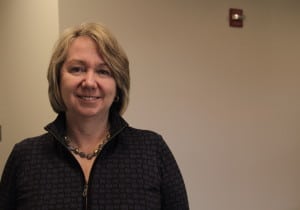Meg McIsaac
Title: President, StonehamBank
Age: 53
Experience: 31 years
Meg McIsaac originally got into banking at her sister’s urging, interning at Bank of Boston and later enrolling in its management training program. She held a variety of roles before she was tapped to turn around Holbrook Cooperative, at the time a troubled institution. It was her connection with StonehamBank’s current CEO, Janice Houghton, that led her to her next challenge. Speaking of the culture that drew her to StonehamBank, McIsaac told Banker & Tradesman, “It’s sincere here. … I think people really appreciate what they do and they want to contribute to the community.”
Q: What are some of your top priorities in your role here at StonehamBank?
A: We have a couple exciting agenda items for 2017. One is to redesign the branch. Part of that is not just from a façade standpoint, but really think about what it is the customer experience, how we want to satisfy their demands and remain relevant. We’ve got an aggressive agenda of redesigning our website, redesigning the branch and focusing on navigators.
We’re also continuing our investment in technology, so that when folks get to us through different channels it’s a fairly seamless experience for them. Say a customer comes to open a personal account with us, but he owns a business and he’s intrigued by what we may have to offer. We want to make it simple for him to get to the right people. It’s really speaking to what the desires of the current banking client are. They don’t want to wait in line, they want their time to be valued, so we’re trying to do pre-planned appointments with lenders and mortgage folks and customer service representatives who may have to deal with probate kind of issues.
Our commercial lending side is very strong. We’ve done very well. That business I think will just run on its own for a while. Our focus really in 2017 is retail.
Q: How do you think about succession planning and investment in your workforce, particularly with respect to the Millennial generation?
A: We are lucky to have a pretty good population of younger folks, and one of the common challenges facing banks, particularly community banks, is succession planning.
We really want to engage the folks who are here and communicate to them that there is a career path, that it’s not a sterile environment and they can hopefully be fulfilled working here. I’ve just started a group and recruited one of the Millennials here to help me with it, to really refine what folks are looking for in a meaningful career. I think unlike in the past, it’s going to be customized by each person.
There’s also a huge commitment and a monetary and time investment in training here. Folks go to Babson, they go to Bryant. The bank pays for their financial certifications or their compliance certifications, you have folks going to Stonier Graduate School of Banking. The board and senior management are very supportive of helping folks feel they’re being invested in and there’s a variety of opportunities for them. So it’s not just, you’re the equipment, we’re using you and then moving on.
Q: What do you see as some of the biggest challenges for community banks in the years ahead?
A: There are the challenges that are less environmentally sensitive, like succession planning or technology – how much do you invest? How much do you outsource? What role does fintech play? – but then there are the more macro issues, and I think right now one of the biggest issues is the rising rate environment. You’ve got 10 years of historically low rates, you’ve got a whole group of business owners who may not have ever operated their companies in a rising rate environment, you’ve got a whole group of lenders and retail-forward facing folks who’ve never dealt with customers in a rising rate environment. That to me is the biggest challenge this year, outside of things like how do you integrate fintech and who’s going to sit in my seat in 10 years?
Q: How are you preparing for the eventual rise in interest rates?
A: We do a lot of modeling and stress testing of our portfolio, and we don’t have a tremendous amount of our portfolio that is on a variable rate product, so that gives us a little bit of insulation. But what we’re doing now is tweaking the model to have the stress test be a little more robust, so instead of a 100 basis points increase, maybe we’ll do 200 and see what happens there. We’re trying to be proactive that way. Our lenders are talking to the customers, [asking them], “What are your plans?” and “How do you think your cash flow will be impacted if you have to pay more for your debt?”
So it’s really leveraging the relationships that we already have with customers. I’m harping on the community bank issue, but we know our customers very well so it’s very easy to touch them, to have those conversations, to be proactive.
We have negligible delinquencies right now and the portfolio is really, really strong and clean, so I don’t foresee that we’re going to have that environmental shift really translate into problem loans. I think it will be more about what the impact on new lending and that volume.
McIsaac’s Top Five Dishes To Make With Chocolate:
- French silk chocolate pie
- Chocolate bread pudding
- Triple chocolate mousse cake
- Espresso chocolate cookies
- Sour milk chocolate cake




 |
| 


